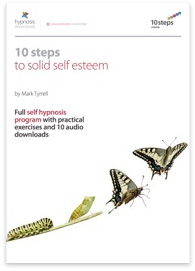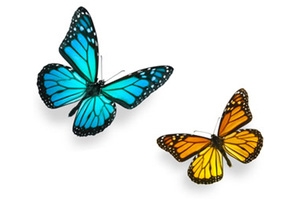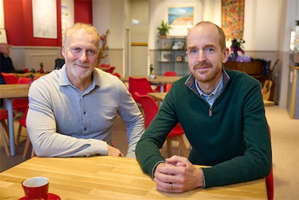How to Overcome Your Negative Self-Image
3 ways to be kinder to yourself
 "A negative self image can get in the way of all kinds of things in life."
"A negative self image can get in the way of all kinds of things in life.""I feel like I'm no good. Like I'm just damaged goods. I can't even put my finger on it. It's just like I feel... unworthy. I feel see-through, as if people are going to look right into me... and hate what they find..
When I asked Susan how she would describe herself I could see the pain playing around her eyes. She bit her lip and her voice dropped to a barely audible whisper. The grown woman before me sounded like a frightened little girl.
"I'm cowardly, ugly, fat, useless, stupid, and selfish."
Susan's description of herself couldn't have been further from the way I saw her. I wondered what mix of experience had gone into creating such a poor self-image. After all, much of what she'd told me about her life showed me she'd been brave, not cowardly. She wasn't fat or ugly, not through my objective eyes. And, far from being useless, she was articulate, intelligent, and had achieved a lot in her life.
Like many people with a poor self-image, Susan was fair and reasonable when it came to other people, but reserved a special corner of mental hell for herself.
So where had Susan's self-image issues come from?
How you learn to see yourself
I learned that Susan had been harshly criticized by her mum and dad as a child. They had wanted the best for her, but instead of encouragement they had heaped criticism upon her.
"Clever girls don't do that!"
"If you dress like that no man will ever want you."
"Why can't you be more like your sister!"
Often our criticisms of ourselves come from other people's criticisms of us. It feels like we are criticizing ourselves but actually we have just adopted other people's condemnations of us - usually at such a deep level that we can't tell the difference.
When I asked Susan whose 'voice' it was when she was criticizing herself, it took some careful thought before she told me it was a mixture of both her parents. She'd taken up the criticism baton from them and had been running hard with it ever since.
To some extent we all learn to compare ourselves to others: to build, almost without realizing it, a self-image. But what is self-image, exactly?
The fall from innocence
"She has a prettier nose than me!"
"I'm not as clever, cool, rich, funny, tall, successful, confident, young!"
"I am an inferior specimen!"
But how did you come to be a 'specimen'? An object to be compared, assessed, praised, or criticized and found wanting?
We're born into the world beautifully unselfconscious. We have an 'I' of pure awareness, in which the self as an object hasn't yet formed in our minds. But, bit by bit, we learn to view ourselves as we imagine others see us. We learn to compare ourselves not just to others, but to our imagined idea of how we should be.
How do we compare?
"I'm 35; I should have my own place to live."
"By now I should be in a settled relationship."
"Am I aging quicker than the people around me?"
Even when we compare ourselves favourably to other people, the fact that we are comparing ourselves at all leaves us vulnerable because one day we might find we don't compare as well as we used to.
And if we tend towards perfectionism - an unachievable goal - then we can never be good enough. And we fall into a trap of our own making.
The cost of Comparanoia
'Comparanoia' - living your life through the lens of the people around you - causes pain. It embitters us, and it tears us to tatters if we let it.
Worrying how we're doing, how we look, and how we seem to others shrinks and spoils the life-expanding spontaneity that we once knew, way back when we hadn't yet learned to objectify ourselves in this way.
I know people who even compare cthemselves to those lucky few who don't seem to compare themselves to others: "I wish I could be free and not care so much what people think."
More often than not, people who chronically compare themselves are aware on some level that they're doing it. They might say, "Yes, I know I've got to learn to think differently." But in a way, just trying to think differently to improve self-image is putting the cart before the horse.
Why you can't think yourself into a positive self image
It wasn't that Susan believed logically that she compared unfavourably with others or that she really was fat, or ugly, or useless. Logically she knew that it shouldn't matter if she wasn't as slim as a supermodel or as rich as a CEO.
But this kind of painful self-image has little to do with thoughts and everything to do with feelings. To help Susan be as fair and kind to herself as she was to others, I had to put her thoughts aside and focus on appealing to her feelings.
Feelings are more powerful than thoughts (because emotions are the tools we use to survive), and that's why it's actually easier to change feelings in order to naturally change thoughts than the other way around. Susan had tried positive thinking, but had just felt guilty for not being positive enough.
Here's what I did for Susan, and it can help you too.
3 Ways to Improve Self Image
1. Be kind to yourself by being calm about yourself
Learning to view yourself 'from the outside' - that is, calmly and objectively - lets you appraise yourself not through the distortions of fear or narcissism, but through calm, fair, and objective assessment. We don't have to believe we are as beautiful as Jennifer Hawkins or as rich as Richard Branson. We just have to objectively understand and accept that everyone is different, and be calm and objective about that rather than tormented. I helped Susan relax deeply into a beautiful hypnotic trance and used an approach called 'The Helping Hand Technique'.
I helped her to first build up a sense of her self-worth and life wisdom by focusing on what she had learned throughout her life. Then, when she felt fully associated with her resources and strengths, I encouraged her to hypnotically help her younger self as if that younger self was someone else.
When she came out of trance, she found that her memories of being criticized and bullied as a child, though still hurtful, no longer affected how she felt about herself now. This was the first step in undoing the negative conditioning from her past. I was helping her to change her feelings about herself so that her thoughts - her self-image - could naturally and easy update, modify, and change.
Improving self-image isn't about trying to force yourself to switch from negative to positive, it's simply about gaining more self-objectivity. Seeing yourself calmly 'from the outside'. But that's only the first step.
2. Don't compare your inside to other people's outside
Feeling we have to be perfect is an imperfect way of travelling through life. It's easy to compare ourselves to some kind of impossible sense of who we imagine we should be, or to a person or people we have deemed 'perfect'.
There is always going to be someone richer, more classically beautiful, more 'successful' - whatever that means. More, more, more. But there are also millions who will always have less of some of your attributes. We all need to try not to compare ourselves to others- but you will slip, and when you do, at least make it a fair comparison. Be careful whom you compare yourself to.
But even then, are we actually comparing ourselves to who other people really are, or who we imagine they are?
It's so easy to look at someone and think they have everything. But they may be looking at us feeling the same thing. Even the most beautiful, witty, clever people have their own inner doubts. After all, nothing is forever. Beauty fades, bodies fail, relationships end, money runs out. Nobody has everything.
One final way we can harness the understanding that self-image stems from feelings rather than logic is through metaphor. Here's how I used this with Susan.
3. Improve self-image with hypnotic metaphor
"It was like I was trying to con myself or something, because although I was trying to think good things about myself inside, I just didn't feel that way."
That's how Susan described her attempts to try to improve her self-image just by trying to think more positively. I explained to her that there are more connections leading from the emotional parts of the mind to the thinking parts than the other way around, which is why trying to change feelings by changing thoughts can be so hard.
Every time I would try to challenge Susan's negative self-image, she would argue with me. Not that I was surprised. Negative self-image is resistant to direct disconfirming feedback, which may even make someone cling more tightly to their painful self-image. That's why metaphor is so useful. Metaphor is an indirect way of communicating with the powerful unconscious mind - the part that actually produces the horrible feelings of inadequacy in the first place.
I took Susan into hypnosis, and I told her metaphorical stories. In this deep state of relaxation, her feelings could calm and adjust, making it natural and easy for her to think in healthier ways. Here's one story I told her that really did seem to have an immediate effect - and it may well help you too.
The Freed Princess
In a dark castle lived a princess who had never seen her own reflection. She'd been locked up for her whole life, until one day found that the door to her palace dungeon had accidentally been left open. Amazed, she stepped free for the first time ever. She walked outside and down to a shimmery lake - another thing she had never seen before. With wonder, she peered into the lake and, for the very first time, saw her own reflection. But it was stormy, the wind was whipping the water, and her reflection was fractured and warped.
Naturally, the princess believed this was how she really was, how she really looked. Jagged. Distorted. Ugly. She began to cry at the 'true nature' of herself. Then a serene elderly lady quietly approached her with a kind smile and warm, understanding eyes. The lady comforted the princess and, as she gently reassured her, the warping wind calmed. Almost instantly, the surface of the lake became even and calm. The sun emerged, and everything felt gentle and peaceful once more. After a moment, the old lady encouraged the princess to observe herself again in the reflection of the now calm lake.
With everything - the elements, her mind, and the very atmosphere - calm and balanced, she now saw herself as she truly was and started to come to know herself.
You can tell yourself how awesome you are until you're blue in the face, but this is not the path to restoring healthy self- image. Calm self-observation is the first step to seeing yourself as you are meant to be seen. As you really are. Not perfect, not terrible - but worthy of respect, and full of potential above and beyond what yourself or others may have said or thought.
Healing not hating
Over the coming weeks we worked on removing the emotional charge from Susan's most troublesome memories so they no longer coloured and dictated her feelings or thoughts about herself. We worked on strategies to help her meet her emotional needs. And she began to use her mind to heal, not hate herself.
We helped her recognize, not as just an idea but as a felt reality, her attributes, her beauty, and her array of potentials. She began to respect herself not because it was something she should do, but as a natural consequence of her newly developed calm after overcoming past harsh conditioning.
Toward the end of our time together, long after I'd assumed she'd forgotten the story I'd told her at the start, Susan looked at me and said:
"I am the freed princess, aren't I."
10 Steps to Solid Self Esteem course
Vanquish that critical inner voice and discover how much easier and happier life is with healthy levels of self esteem...







